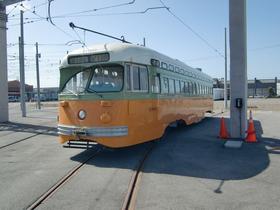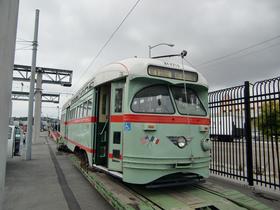The other day, we showed you derelict PCC No. 1009, off for a total rebuilding as part of Muni’s contract with Brookville Equipment. Five PCCs, all original Muni vehicles, are getting that complete restoration. Another 11 PCCs that have been partly restored are part of the contract as well, getting completely rewired.
In the past couple of weeks, two of those 11 cars changed places. Their paint schemes look different, but both represent a controversial company. Starting shortly before World War II, a company named National City Lines (NCL) started buying up privately owned streetcar systems around the country and converted them to buses. NCL was financed by giant companies that made buses, tires, and fuel. They were convicted of conspiracy charges in Federal court but got off with a slap on the wrist.
(It must be said that most streetcar infrastructure, including cars, track, and power systems, was completely shot at that time, and rising costs had deprived private system owners of the capital to rebuild, but that’s a separate story for another time.)
PCC No. 1080, back in San Francisco from the Pennsylvania contractor with new wiring, is painted in tribute to Los Angeles Transit Lines, renamed from Los Angeles Railway when NCL bought it in 1945. Unlike most of its other properties, though, NCL actually bought *new* streetcars in Los Angeles, identical to this body style, for its very busy Pico line in 1948.
This yellow green and white scheme was NCL’s standard. It was also applied to the operation they renamed El Paso City Lines, with streetcars that actually crossed the border into Juarez, Mexico. In the 1950s, though, these cars were repainted into a pea green and red scheme which is seen on Muni PCC No. 1073. This car recently left for Brookville for its rewiring. This leaves only three of the 1070-class streetcars operating in San Francisco, Nos. 1075, 1076, and 1077.
No. 1080 will soon enter testing, joining No. 1071 as the first rewired cars to return to San Francisco from Brookville. Muni is looking closely at the new door mechanisms in particular to ensure that the cars will hold up to heavy F-line service before accepting them from the contractor. No date is yet set for either 1071 or 1080 to enter passenger service.
National City Lines may not be a happy part of U.S. streetcar history, but it’s a significant part, and by next year we should see both examples of it on the streets of San Francisco.


Hi,
Do you have an idea of when all remaining streetcars will be fitted with GPS?
@Matthew, short answer is no. The vendor, NextMuni (NextBus) is responsible for the GPS installation, but there has to be low voltage circuitry on the streetcar first, which is Muni’s responsibility. All the PCCs and Milan trams have low voltage and GPS, and a couple of the older, one-of-a-kind cars have low voltage. We’re focusing on those cars first and trying to come up with low cost temporary solutions for the others.
It’s also worth noting that the same livery was used on the Montgomery, Alabama bus that Rosa Parks made infamous, as it was also an NCL bus—and that one can be seen on the website of the Ford Museum in Deaborn, Mi. where it has been gloriously restored, a reminder to Muni that it has a fleet of vintage buses that ought to be out there with the vintage streetcars (I have to laugh though, as hearing that would probably give anybody at Muni HQ a headache on top of the one they already have in these tough times).
What about the other cars from the Newark, New Jersey batch? Car 1070(Newark New Jersey), 1072(Mexico City), 1073(El Paso, Texas), 1074(Toronto, Canada), 1078(San Diego), and 1079(Detroit, Michigan)? are these cars still at Brookfield Equipment? Do let me know
@Frank, go to our streetcar roster page and you can always see the status of each streetcar in the fleet. /streetcarroster/
I recommend that anybody interested in the “streetcar conspiracy” theory to locate the January 2006 issue of Trains magazine and read an article by John Diers titled “Did a conspiracy really Kill the Streetcar?” Best article: “Did A Conspiracy Really Kill The Streetcar?” takes apart a widely repeated myth, that evil National City Lines, backed by GM, was responsible for the abandonment of streetcar systems across the land. John Diers points out who was responsible: “everyone who bought an automobile between 1920 and 1950…..along with US automakers, the banks and financial institutions that profited from auto loans, and the state, local and federal governments that paved highways.”
Given all of the press and PBS specials about how Big Bad GM was single-handedly responsible for destroying the street railway industry, it’s nice to have a long-time industry professional attempt to set the record straight. He does this by using the Twin Cities experience as a case study but the results can be extrapolated to the rest of the world. Bottom line, the rise of the automobile, and pro-car government policies, supported by a willing motoring public, are to blame, not NCL. We have met the enemy and he is us, or some such. Anyway, if GM’s to blame, how come streetcars died in non-NCL cities in the US, and, oh, by the way, around the world? For example, Great Britain ripped up all but one of its conventional tram routes by 1980. GM/NCL’s fault? Not bloody likely. Anyway, this article should be required reading for anyone interested in transit history.